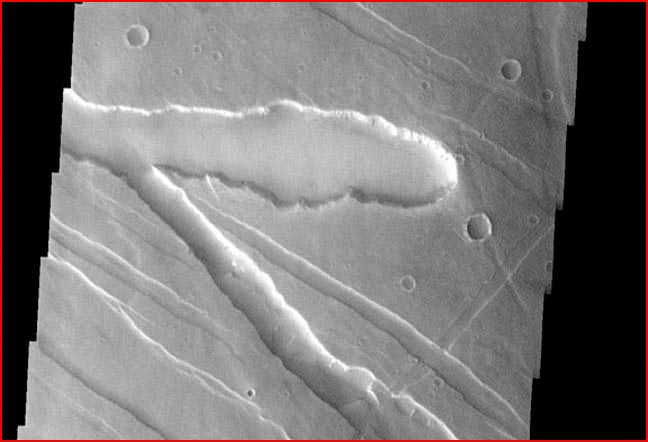
home •
about •
essential guide •
picture of the day •
thunderblogs •
news •
multimedia •
predictions •
products •
get involved •
contact
picture of the day archive subject index
Credit: NASA/JPL/Arizona State University
Dec 27, 2006
Etched MarsGrooves of widely varying sizes appear etched on the surface of Mars. The grooves indicate a removal of material by forces unknown to planetary geologists. But a force familiar to plasma physicists -- electrical arc machining -- etches grooves with these exact characteristics.
Grooves such as these appear etched into the surface of Mars. Although their sizes vary enormously, their outstanding features are the same: parallel, steep sides, often scalloped; flat bottoms; sharp intersections that leave each groove undisturbed by the other; flat terraces; sudden terminations that sometimes skip over intervening terrain, leaving "land-locked" basins; and everywhere an absence of the debris that familiar erosional processes should leave. The grooves indicate a removal of material by forces unknown to planetary geologists.
But a force familiar to plasma physicists etches grooves with these exact characteristics: Electrical arc machining. The electrical forces constrain the arc to contact the surface at a 90-degree angle. Because the arc typically consists of one or more pairs of channels that rotate around a common axis, a stationary arc will etch a circular crater. Most of the etched material is lifted from the surface, and the material around the edge is pinched up into a sharp rim. If the rotating channels are sufficiently far apart, they may leave a "peak" of undisturbed material in the center of the crater. Fluctuations in the current may cause variations in the depth and diameter of etching, leaving terraces along the walls.
If the arc travels across the surface, it will etch away material to a uniform depth and leave a groove with parallel sides exactly the width of the arc's rotation. Uneven movement may result in a series of overlapping circular craters, producing scalloped edges, or a jumping of the arc, producing linear chains of craters. When a traveling arc crosses the groove etched by a previous arc, it will be unaffected by the change in terrain. Sometimes a "ghost" of the earlier groove will be preserved as the later arc etches its uniform depth down one side and up the other. (An example of such "ghosting" can be seen at upper right in the image.) In a process similar to the jumping that produces crater chains, an arc may etch a groove and then jump a ways before etching more of the groove, leaving lines of isolated basins.
The two outstanding characteristics that distinguish electrical arc etching from mechanical erosion processes are the small amount of debris left by etching and the considerable melting of crater and groove floors. The lack of debris in and around features on Mars has already been noticed. Landers should soon begin reporting evidence of glassification.
___________________________________________________________________________Please visit our Forum
The Electric Sky and The Electric Universe available now!

|
|

|
EXECUTIVE EDITORS:
David Talbott, Wallace Thornhill
MANAGING EDITORS:
Steve Smith, Mel Acheson
CONTRIBUTING EDITORS: Dwardu Cardona, Ev Cochrane,
C.J. Ransom, Don Scott, Rens van der Sluijs, Ian Tresman
WEBMASTER: Brian Talbott
Copyright 2006: thunderbolts.info
![]()
home •
thunderblogs •
forum •
picture of the day •
resources •
team •
updates •
contact us

